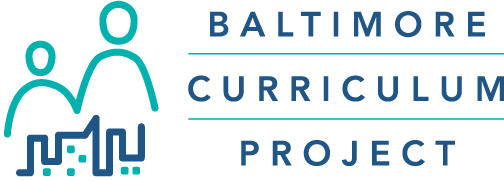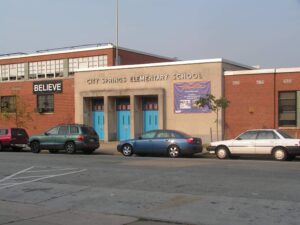 We continue our examination of the impact Baltimore Curriculum Project (BCP) neighborhood conversion charter schools are having on the redevelopment and regrowth of underserved neighborhoods across Baltimore with the historic City Springs Elementary/Middle School and the equally historic Perkins Somerset Oldtown (PSO) neighborhoods in Southeast Baltimore.
We continue our examination of the impact Baltimore Curriculum Project (BCP) neighborhood conversion charter schools are having on the redevelopment and regrowth of underserved neighborhoods across Baltimore with the historic City Springs Elementary/Middle School and the equally historic Perkins Somerset Oldtown (PSO) neighborhoods in Southeast Baltimore.
City Springs Elementary was established in 1966 as a traditional public school to support the Perkins Somerset Oldtown (PSO) community. However, by 1996, the school was struggling with low academic performance; no third or fifth graders had passed the state’s standardized tests in math or writing. To address these challenges, City Springs became the first school operated by the Baltimore Curriculum Project (BCP) as part of the New Schools Initiative, adopting the Direct Instruction (DI) model.
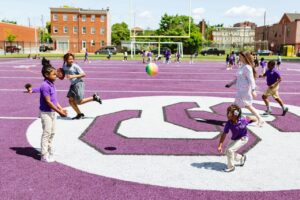 A few years later, BCP successfully transformed City Springs from one of the lowest-performing schools in Baltimore into a model for educational reform. This achievement gained local recognition and became a significant part of state history. City Springs became only the second school in Baltimore City and the fourth in Maryland to be removed from the state’s list of schools eligible for reconstitution, which identifies the lowest-performing schools.
A few years later, BCP successfully transformed City Springs from one of the lowest-performing schools in Baltimore into a model for educational reform. This achievement gained local recognition and became a significant part of state history. City Springs became only the second school in Baltimore City and the fourth in Maryland to be removed from the state’s list of schools eligible for reconstitution, which identifies the lowest-performing schools.
In 2005, BCP converted City Springs into a charter school, providing it with greater flexibility to enhance academic reforms and expand community partnerships. Over the past 20 years, BCP has worked closely with City Springs to identify community needs and enhance support amid the evolving political and educational landscape. This collaboration has included the implementation of restorative practices, the adoption of the community school model, and the development of the purple field, among other initiatives. In 2025, the Baltimore City Board of School Commissioners renewed City Springs’ charter for an additional five years, underscoring the school’s ongoing progress and its vital role in the community.
The Fund for Educational Excellence recently published a report, Seen and Heard: How Student Belonging Shapes School Communities and Student Success. City Springs is the first case in the national study that showcases schools that have built a strong climate and culture where their students feel seen, valued, and empowered to succeed.
A Community Reimagined: The PSO Transformation Initiative
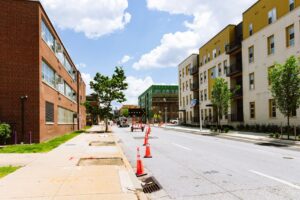 City Springs sits at the center of the Perkins Somerset Oldtown (PSO) Transformation Initiative—one of the most ambitious redevelopment efforts in Baltimore’s history. This multi-phase plan seeks to rebuild three of the city’s most storied neighborhoods—Perkins Homes, Somerset Homes, and Oldtown—into a vibrant, mixed-income community while honoring the rich histories rooted in each.
City Springs sits at the center of the Perkins Somerset Oldtown (PSO) Transformation Initiative—one of the most ambitious redevelopment efforts in Baltimore’s history. This multi-phase plan seeks to rebuild three of the city’s most storied neighborhoods—Perkins Homes, Somerset Homes, and Oldtown—into a vibrant, mixed-income community while honoring the rich histories rooted in each.
Perkins Homes, originally constructed in 1942, was one of Baltimore’s largest public housing developments, established during segregation to serve low-income families. Somerset Homes, active from 1943 to 2008, held deep cultural and civil rights significance for Baltimore’s African American residents. Oldtown, with origins dating back to the 18th century, was once a bustling center of Black-owned businesses and a hub for neighborhood commerce and community life.
As these areas saw economic decline through the late 20th century, disinvestment led to deteriorating conditions, prompting a comprehensive response in the form of the PSO Initiative. Today, the plan is transforming these neighborhoods into inclusive, sustainable communities—with City Springs at the educational and social core.
Key Milestones in the PSO Transformation
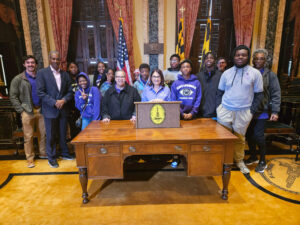 The PSO redevelopment is already delivering tangible results. In 2018, the Housing Authority of Baltimore City secured a $30 million federal Choice Neighborhoods grant from HUD to support the transformation of Perkins Homes. The redevelopment—now known as Perkins Square—will eventually include over 1,300 new mixed-income residences.
The PSO redevelopment is already delivering tangible results. In 2018, the Housing Authority of Baltimore City secured a $30 million federal Choice Neighborhoods grant from HUD to support the transformation of Perkins Homes. The redevelopment—now known as Perkins Square—will eventually include over 1,300 new mixed-income residences.
By 2023, the first phase was completed, introducing 103 new housing units. A year later, in 2024, the second phase followed, advancing the city’s vision of a modern, equitable neighborhood. The nearby Somerset Homes site is also being redeveloped with new housing, and plans for the revitalization of the Oldtown commercial corridor—once home to the iconic Bel Air Market—are underway.
The transformation includes not only housing but also public spaces and infrastructure. New parks, including a two-acre green space at Perkins Homes and a one-acre park at Somerset, are being created. Renovations to the Chick Webb and Madison Square recreation centers, along with modernized streets, sidewalks, and utilities, further reflect the city’s comprehensive approach.
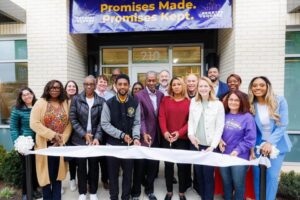 Further reinforcing its foundational role in the PSO community, City Springs is now preparing to enter a new chapter with the construction of a brand-new, state-of-the-art school building. In November 2023, the Baltimore City Board of Estimates approved a $69 million plan to replace the school’s aging 60-year-old facility. Designed to support modern instructional needs and community engagement, the new building will feature enhanced learning environments, multipurpose spaces, and updated technology infrastructure.
Further reinforcing its foundational role in the PSO community, City Springs is now preparing to enter a new chapter with the construction of a brand-new, state-of-the-art school building. In November 2023, the Baltimore City Board of Estimates approved a $69 million plan to replace the school’s aging 60-year-old facility. Designed to support modern instructional needs and community engagement, the new building will feature enhanced learning environments, multipurpose spaces, and updated technology infrastructure.
The construction project—scheduled to begin in 2025 and be completed by 2027—is being funded through a collaboration between Baltimore City Public Schools, the City of Baltimore, and the Maryland Stadium Authority. The building is expected to open in time for the 2027–2028 academic year, providing students with a transformative space that reflects the school’s academic aspirations and its role as a community hub.
Education as the Cornerstone
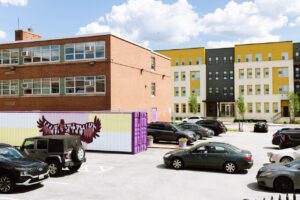 City Springs’ steady academic progress and deep community partnerships have made it a trusted institution in the lives of PSO families. The school continues to serve as a stabilizing force during a time of transition, providing continuity for students while embracing the broader goals of community renewal.
City Springs’ steady academic progress and deep community partnerships have made it a trusted institution in the lives of PSO families. The school continues to serve as a stabilizing force during a time of transition, providing continuity for students while embracing the broader goals of community renewal.
City Springs staff work closely with PSO partners to ensure that families receive holistic support. A human services plan led by Baltimore City provides resources to help residents achieve greater economic self-sufficiency. Job creation is a priority as well, with over half of new employment opportunities in the area reserved for local residents.
As the neighborhood evolves, City Springs remains a constant—anchoring the community’s future in the same way it has for generations, but with renewed purpose and strengthened capacity. Its transformation is proof of what’s possible when strong schools and strong neighborhoods grow together.
